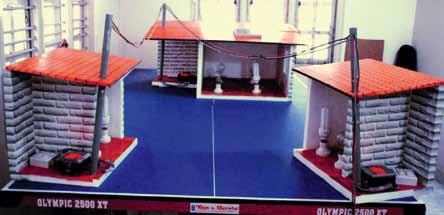Microgrid is basically a small-scale power supply network that is designed to provide power for a small community. It can-not be used for high-power consuming devices but can be used as an alternative approach to integrate small-scale distributed energy resources into low-voltage electricity systems. Enabling local power generation, it comprises various small power generating sources that make it highly fexible and efficient.
Basically, the solution aims to electrify houses that are not directly connected to the electricity board power grid due to their remoteness. To be precise, “We have integrated existing hardware components in the market with a powerful embedded system. The setup forms an electricity grid that is small enough to be called a microgrid. This system is powered by renewable energy sources such as solar photovoltaics (PV), wind and micro-hydel. It can be remotely monitored from anywhere in the world,” explains Ganesh Shankar, managing director, FluxGen Engineering Technologies.
Fig. 1 shows the model of the smart renewable energy microgrid.

From concept to product
“Over 400 million Indians either do not have access to electricity or have intermittent access to electricity. Connecting the whole country to the main electricity grid is a task that would take several years and in some places it may not make an economic case,” points out Hari D.K., chief engineer, FluxGen Engineering Technologies. Distributed energy generation and distribution can potentially solve this problem.
An off-the-grid renewable energy plant connected to a network of houses in rural areas will potentially provide them the same quality of power as obtained from the main electricity grid.
“In India, electricity grid penetration is very poor. Fortunately, the communication network penetration in India is much higher. This makes the case for a smart microgrid whose performance can be remotely monitored and virtually supervised,” says Shankar.

“We are planning to put our systems in places where there is no electricity. But in case the grid does penetrate, the microgrid should ideally be compatible with the grid for the following reasons:
1. It could optimally utilise grid power and renewable energy power, ensuring that the customers get electricity most of the time.
2. If power generated from the renewable energy source is in excess, it should be able to feed it back to the grid so that other microgrids connected to the network could utilise it,” he said.
Regarding the time taken in developing their concept to product, Shankar says, “Before starting Flux-Gen I was working with GE. There I happened to work on building smart energy meters for about six months. During that time, I got a good understanding of smart grid. After quitting GE, I worked with Selco Solar, a rural electrification company, for about five months. So when I started FluxGen, I wanted to club my experience of working on smart grid to rural electrification so that rural dwellers could have a standard of living as good as an urban dweller’s. Then I decided to pursue the microgrid as I could see the value in it. The whole process duration from inception to working prototype can be estimated as three years.”

What makes it different
Microgrid is an idea that has been in the picture for quite some time now. Talking about how their solution differs from the microgrids existing in India, Hari reveals, “There are several microgrids set up in India, but most of them are based on DC transmission. We have developed an AC microgrid system.”
Giving rural houses AC instead of DC will allow them to avail all the facilities an urban dweller could get. Ganesh explains, “Electrical wiring done in the microgrid is similar to that of the main grid, except that it will be connected to lot lesser number of houses. Hence consumers of power from the microgrid will be able to run any electrical appliance that they have.”
Ganesh adds, “While they wouldn’t have much limitation on instantaneous power consumption, the total energy they can get from such a microgrid could be limited based on the size of the plant as the total size of the plant will be limited by the number of solar panels and other energy sources, unlike the main grid which, technically, can give you any amount of electricity you are willing to buy.”








